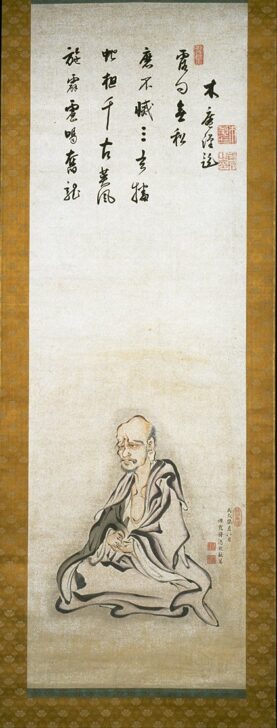Deshan, from triptych of Three Zen Masters: Linji, Bodhidharma and Deshan
Yiran Xingrong (J. Itsunen)

Description
Yiran Xingrong (Itsunen)
Japan, 1601-1668
Triptych of Three Zen Masters: Linji, Bodhidharma and Deshan
Edo period (1615 - 1868)
1658
Hanging scroll, ink and light color on paper
Museum purchase, Acquisition Fund, 1975/2.181-183
Yiran Xingrong was born in Ming Dynasty China (1368-1644), but emigrated to Japan as a spice
trader, eventually entering the Zen temple Kōfuku-ji in Nagasaki. As a monk, he sought to forge
closer connections between Japanese Zen Buddhism and Chinese Chan Buddhism, and
eventually convinced other Chinese monks to establish the Ōbaku Zen sect of Buddhism in
Japan. This triptych shows three Zen patriarchs: Bodhidharma the monk who brought Zen
Buddhism to China, flanked by the monks Linji and Deshan shown on the right and left
respectively. The inscriptions were written by Muyan, one of the main founders of Ōbaku Zen.
Both the casual depictions of these patriarchs as well as the seemingly irreverent tone of the
inscriptions reflect the Zen Buddhist seemingly iconoclastic interest in complete detachment
from the physical world, including Buddhism’s own teachings. The inscriptions may be
translated as follows:
Bodhidharma:
“The barbarian monk with green eyes certainly talks a lot!
Hist teeth open to the wind, he is filled with a haughty spirit.
He agitated the Liang Emperor, while his own heart became more empty,
Unconcerned, he sat in the cool, near the twin trees by the riverbank.”
Linji:
“When he shouted in a voice like thunder,
He aroused the monks’ inner spirit
His wisdom has been polished for a thousand years but never lost;
He taught the three mysteries and did not ask for the Buddha.”
Deshan:
“A single dot in the great void, a single drop in a huge gully;
He burned up the sutra when enlightenment appeared.
He points to sages and commoners alike with his stick.
This this world of karma, he is true Buddha.”
(Translation by Stephen Addiss)
Usage Rights:
If you are interested in using an image for a publication, please visit https://umma.umich.edu/request-image/ for more information and to fill out the online Image Rights and Reproductions Request Form.